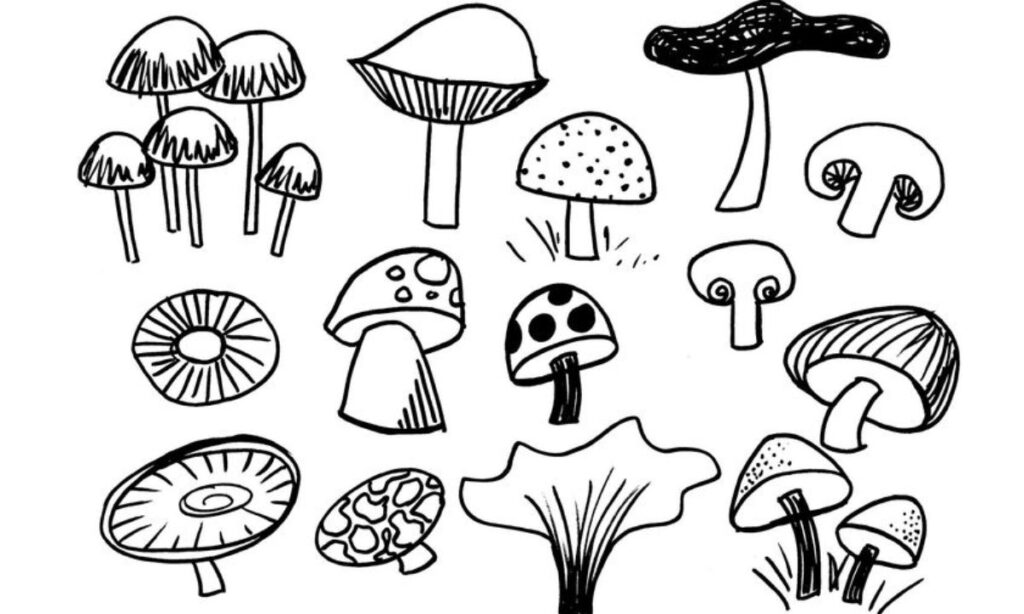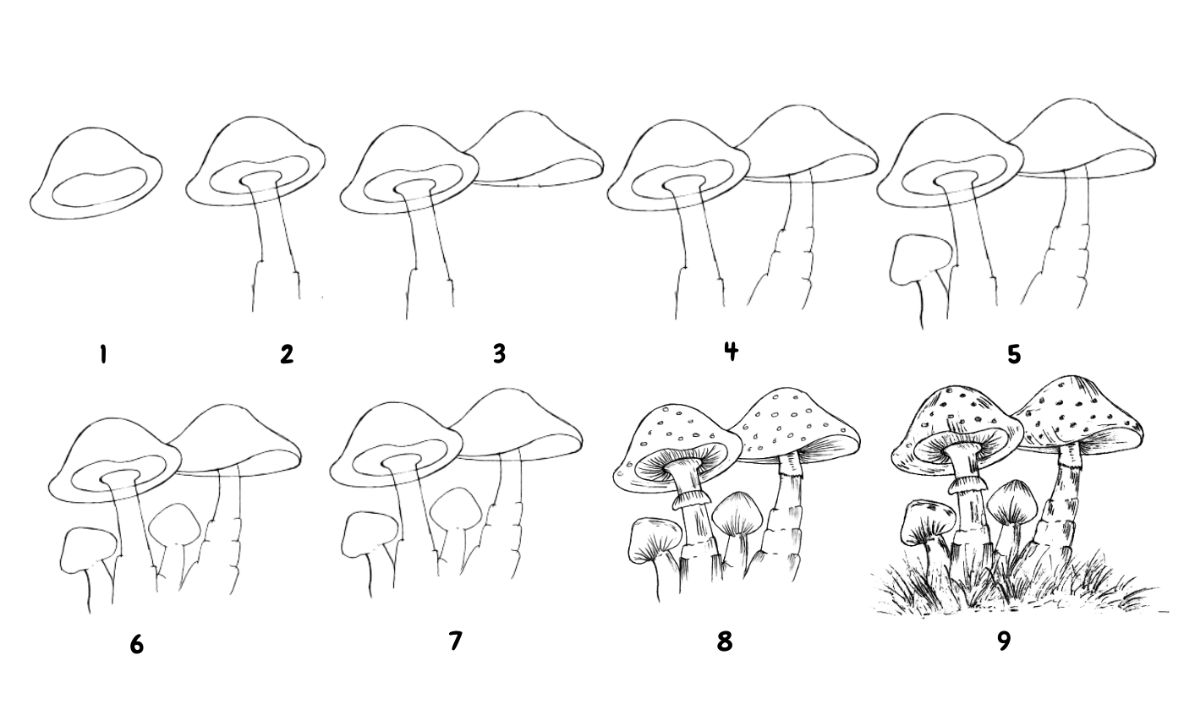Drawing mushrooms is an art form that captures the unique beauty of fungi. It involves creating visual representations of various mushroom species on paper or digital media. This skill combines observation, technique, and creativity.
Artists can depict mushrooms realistically or stylize them for artistic effect. Drawing mushrooms allows us to appreciate their diverse shapes, colors, and textures. It’s a popular subject in botanical illustration and nature sketching.
Many artists find mushroom drawing both challenging and rewarding. The process requires attention to detail and patience. Mushroom drawings can range from simple sketches to complex, highly detailed artwork.
My Personal Experience with Drawing Mushrooms
My journey into mushroom drawing began during a nature hike. I stumbled upon a cluster of colorful fungi and was instantly captivated. That day, I sketched my first mushroom in a small notebook. The experience was both frustrating and exhilarating. I struggled to capture the delicate gills and the curve of the cap.

The challenge only fueled my interest. Over time, I developed a deep appreciation for the intricate details of mushrooms. I learned to observe their unique characteristics more closely. Each drawing session became a meditation on nature’s complexity. I experimented with various techniques and materials.
My skills improved, and I found great joy in the process. Drawing mushrooms has enhanced my connection to the natural world. It has taught me patience and the value of careful observation. I see the forest floor with new eyes, always on the lookout for interesting specimens to draw.
Essential Tools for Drawing Mushrooms

Materials Needed
To start drawing mushrooms, you’ll need some basic supplies.
Here’s a list of essential tools:
- Sketchbook or drawing paper
- Pencils (HB, 2B, 4B, and 6B)
- Eraser (kneaded and rubber)
- Sharpener
- Fine-liner pens (various sizes)
- Colored pencils or watercolors (optional)
- Magnifying glass for observing details
- Reference photos or live specimens
Quality materials can significantly improve your drawings. Choose acid-free paper to prevent yellowing over time. Invest in good-quality pencils for smoother lines and shading. A kneaded eraser is gentle on paper and allows for precise corrections. Fine-liner pens are great for adding crisp details to your sketches.
Read This Blog: Ark: Survival Evolved () Game Icons Banners
Read This Blog: Ark: Survival Evolved () Game Icons Banners
Step-by-Step Drawing Guide
- Begin with careful observation. Study your subject closely, noting its overall shape and unique features.
- Start with a light sketch. Use an HB pencil to outline the basic form of the mushroom.
- Define the cap shape. Pay attention to whether it’s round, flat, or conical.
- Draw the stem, considering its thickness and any curves or bulges.
- Add details to the cap, such as scales or warts if present.
- Sketch the gills or pores underneath the cap. Note their arrangement and density.
- Refine the outline using a softer pencil (2B or 4B) for darker lines.
- Begin shading to add depth and texture. Use light, circular motions for smooth surfaces.
- Enhance shadows and highlights to create a three-dimensional effect.
- Add fine details like veins on the stem or texture on the cap using a sharp pencil or fine-liner.
- If desired, introduce color with colored pencils or watercolors.
- Finally, erase any unnecessary guide lines and clean up your drawing.
Remember, practice is key to improving your mushroom drawing skills. Start with simple shapes and gradually tackle more complex specimens.
Tips for Improving Your Mushroom Drawings

Read This Blog: Unlock Your Home’s Potential with https//decoratoradvice.com: Transformative Decor Tips
Common Mistakes to Avoid
When drawing mushrooms, beginners often make certain errors. Being aware of these can help you improve faster. One common mistake is oversimplifying the mushroom’s shape. Mushrooms have complex forms that require careful observation.
Another error is ignoring the subtle curves and undulations of the cap and stem. Pay close attention to these details for more realistic drawings. Many artists struggle with depicting the gills accurately. Take your time to observe and render their arrangement correctly. Overworking the drawing is another pitfall.
Know when to stop and avoid adding unnecessary details. Some beginners neglect the surrounding environment, which can provide context and interest to the drawing. Finally, rushing through the process can lead to inaccuracies. Take your time and enjoy the meditative aspect of mushroom drawing.
Frequently Asked Questions
How long does it take to become proficient at drawing mushrooms?
Proficiency varies, but with regular practice, you can see significant improvement in a few months.
Do I need to draw from live specimens, or can I use photographs?
Both are useful. Live specimens offer the best observational experience, but photos are convenient for practice.
What’s the best way to draw mushroom gills accurately?
Start with light, evenly spaced lines radiating from the stem, then add depth with shading.
Can I use digital tools for mushroom drawing?
Yes, digital drawing tablets and software can be excellent for mushroom illustration.
How do I capture the translucent quality of some mushroom caps?
Use light layers of shading and leave some areas unshaded to create a sense of translucency.
Conclusion
Drawing mushrooms is a rewarding artistic pursuit that combines scientific observation with creative expression. It offers a unique way to connect with nature and develop your artistic skills.
Through practice and patience, anyone can learn to create beautiful mushroom illustrations. The process of drawing mushrooms enhances our appreciation for these fascinating organisms. It trains our eyes to notice the subtle details and variations in the natural world. As you progress in your mushroom drawing journey, you’ll likely find it impacts how you perceive your environment.

Amelia is a skilled SEO expert with a strong focus on content writing, keyword research, and web development. With a dedication to delivering results, she helps businesses optimize their online presence and drive organic growth.
Her expertise ensures that clients stay ahead in the ever-evolving digital landscape












